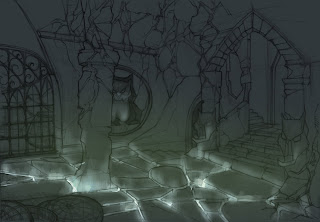
Katie did a great job of illustrating the principles of the rhythm chart, so I don't think I need to go into that as much. This is a quick paintover to address some of the other issues concerning your portraiture. One thing about overly symmetrical facial features is that the face tends to lose some of its charm. While you should do your best to obey the rhythm chart, you also have to consider the subtle sideways smile, the half-smile, one eye closed more than another, one eyebrow slightly raised more than the other--these things give your character, well, more character. You should maintain your proportions, but don't be a slave to it. Flip it horizontally and make sure it works both ways, but keep in mind the feel. Does it still feel like your character? If not, ask yourself, who is she and why does this person not feel like her? Too tough? Too flirty? Too generic??
There are some numbers here that I want you to take note of:
1 - Less is often more. Don't worry about wildly glaring highlights on the forehead. Makeup artists often powder models before shots to make sure there is not as much unsightly glare. The forehead shouldn't be completely smooth or highlight free, but some nice smooth gradations with good color variation will really help.
2 - Watch out for spaghetti-hair (as James Gurney calls it.) Try to begin graphically, like JC Leyendecker. Consider the silhouette and consider a "chunk" of hair at first. Work in broad strokes first, moving to more specific shapes. Remember not to get lost in the details and revert back to spaghetti hair. Keep as much of the graphic feel as you can get away with without losing believability.
3 - On flesh like this, try to get a good gradation between the edge of the core shadow on the light side which is warmer, transitioning to the slightly cooler and darker shadow and reflected light side. Again, in this area, less is more. Overly evident brush strokes can look either unfinished, or they can age her.
4 - careful with the shadow side around the lips. You don't want a phantom mustache.
5 - The angle of the cheeks and how they insert into one another is very important. It will determine if you have a strong main character, a supporting actress (the "friend") or the sweet homely extra within millimeters. You don't have to do what I did, but really look at reference of different women's faces and see what characteristics those angles have and why. All these things will give you the control, and you will be able to get subtle nuance that really adds life and appeal to a face.
Good luck!



















 These are my final pieces, still wish I could tie it down more, but I think im numb now.
These are my final pieces, still wish I could tie it down more, but I think im numb now.




























